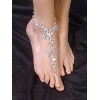|
 All told, ankle bracelets is a little bit absurd since the word «bracelet» in French stands for «wrist»
coming from the «bras» as hand. Thus, we have it as paradox wrist adornment for
feet. Anyway, the anklets is accepted as the unique ring accessory made
from metal, stones, leather and whatever the designers can create from. All told, ankle bracelets is a little bit absurd since the word «bracelet» in French stands for «wrist»
coming from the «bras» as hand. Thus, we have it as paradox wrist adornment for
feet. Anyway, the anklets is accepted as the unique ring accessory made
from metal, stones, leather and whatever the designers can create from.

Traditionally
bracelets are worn on wrists and feet.
Bracelets
created by ancient people were not considered as decorations and jewelry at
all, they were predominantly created to protect from evils and diseases.
Earlier the bracelets were made from bones, minerals, tooth and feather. With
the time by, bracelets acquired the magic power, and later on it acquired the
social meaning.
Consider the
ancient frescos when kings and pharaohs were painted wearing all bracelets!
Ancient Egypt
is also the place where golden bracelets made the epoch of culture. The
remaining wall paintings show noble Egyptians with lots of golden bracelets on
their wrists. The German warriors wore bracelets as the symbol of bravery that
was like the amulet to protect in battles.
In the North Europe golden bracelets won the popularity of men
mainly. The bracelets predominantly were worn over the clothes unlike natives
of South countries who preferred wearing them on the bare wrist. In Russia people discovered
bracelets very late, in 11 - 13 centuries, they were called hoops that were
worn over the collar instead of the cuff.
Preliminary
bracelets were applied during sacral ceremonies as the items of ethnical
culture. In course of time, the sacral meaning was lost and bracelet became the
element of clothes, while noble women wore golden and silver bracelets,
townswomen preferred glass bracelets, while peasant women afforded copper
bracelets.
The social distinction
was noted in wearing all kinds of jewelry, like tiaras, earrings, necklaces or
expensive women bracelets that were not allowed for hay seeders since they
symbolized sacral power and authority. Bracelets are discovered during archeological
digs and inside the ancient Egyptian pyramids, and in the territory of the
former Kievskaya Rus.
During the Middle
Ages in Europe bracelet outdated for that time
the clothes with long sleeves was common and well practiced. Though in the Renaissance
Age the sleeves get shorter, hands are opened and people start wearing
bracelets again. In the course of the history the sacral meaning of bracelets
faded, as well as the symbolical meaning of jewelry and bracelets on the whole.
On the top of it, they appeared to be the sign of prosperity, well-being and wealth.
In our
times bracelets bring to fashion in various ways. Bracelets came from Eastern
countries where low-waist line trousers and ankle bracelets were common to the
culture of Eastern countries. Though bracelets were worn on both feet traditionally.
In India early
people wore bracelets on both feet, both from gold and solver. They dangled when walking and dancing. Anklets were of two types. One type included bracelets consisting of
different links making one chain. Such decorations were very flexible. They
were long-lasting enough to add some more elements like bells or other dangling
and jingling figures to create unique and special sounds when dancing. The other
type of bracelets appeared as springy and non-flexible knick-knack made of the
single band of metal. This classification is accepted for bracelets up to date.
As following this tradition, charms are very popular currently, presented as a
solid chain with dangling small pendants
attached to it that symbolize major life events. Tiny key means the purchase of
a new flat, mini-binky is the sign to say that a baby is born, and so forth.
The other way
to bracelets origin comes from the East as well, though it is paved through
Europe and America
where ankle bracelets were set as trend in the early XX century. This new trend
gave some sexuality to wearing bracelets on feet. By the tradition bracelets
were usually worn as a decoration on the right foot only as the expression of
freedom and availability, while the bracelet on the left foot was the sign of a
woman of pleasure. Though, this is fascinating that some time back in the West
ordinary peasant people wore the chain on the foot instead of the wedding ring
to symbolize the marriage.
As soon as America was
discovered, this weird tradition to stay faithful followed there too. American
girls still wear ankle chains, though in the course of time this decoration
changed the meaning and now it is acknowledged as the sign telling that the
bracelet wearer is free and does not mind to become friends or get affair with
a young man.
In the
majority, ladies wear this decoration to underline the beauty of their legs and
feet, without any secret meaning. So, it is up to you, whether you will opt to
have the ankle bracelets as the creative ethnic thing, as the sign of femininity,
as the sign of prosperity if made from gold or platinum. Sometimes you may have anklets on your foot just because your tanned leg needs and accessory to express your
tan. And avoid thinking negatively, just enjoy the beauty and looks of men you
face when walking or swimming. Men should be attracted by you, in all and every case.
Inessa Hyder

|